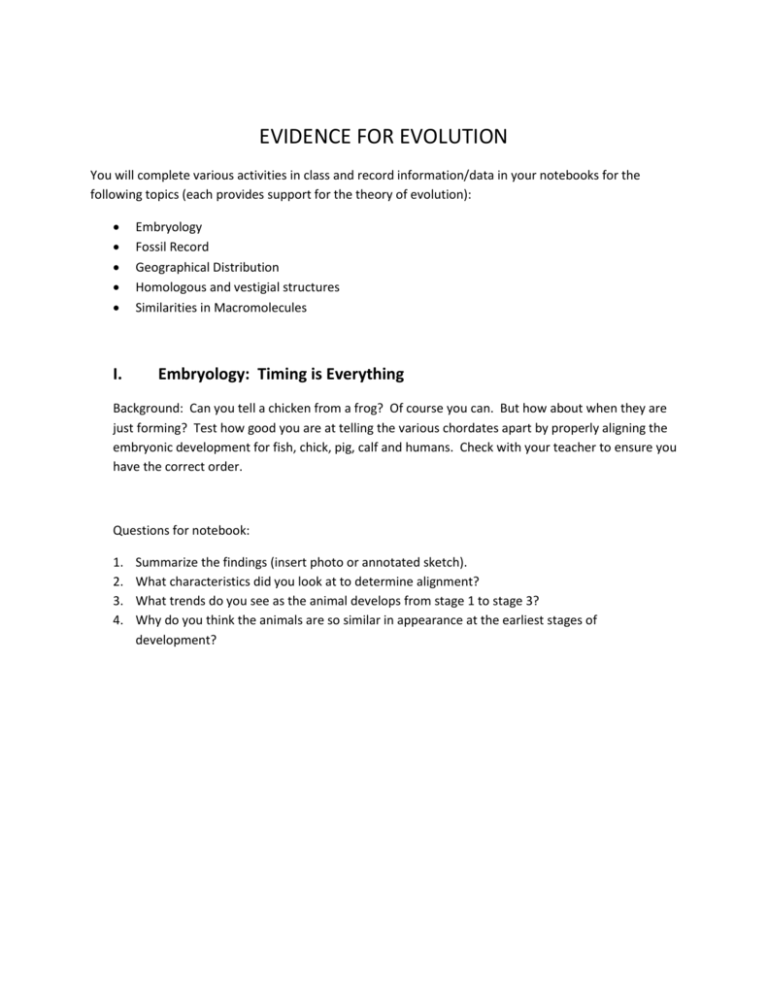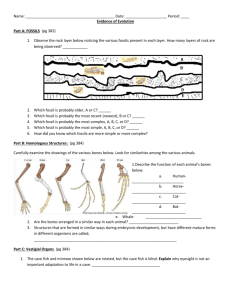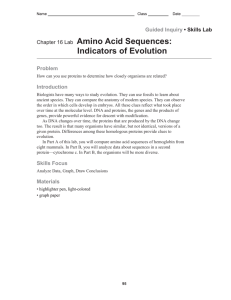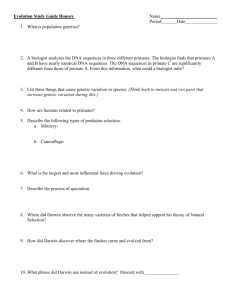of evolution. - Haiku Learning
advertisement

EVIDENCE FOR EVOLUTION You will complete various activities in class and record information/data in your notebooks for the following topics (each provides support for the theory of evolution): I. Embryology Fossil Record Geographical Distribution Homologous and vestigial structures Similarities in Macromolecules Embryology: Timing is Everything Background: Can you tell a chicken from a frog? Of course you can. But how about when they are just forming? Test how good you are at telling the various chordates apart by properly aligning the embryonic development for fish, chick, pig, calf and humans. Check with your teacher to ensure you have the correct order. Questions for notebook: 1. 2. 3. 4. Summarize the findings (insert photo or annotated sketch). What characteristics did you look at to determine alignment? What trends do you see as the animal develops from stage 1 to stage 3? Why do you think the animals are so similar in appearance at the earliest stages of development? II. FOSSILS A. Fossil Record - morphology Background: While examining a stream bed, a paleontologist discovered many fossils that were all identified as belonging to the genus Barbellus. Before proceeding, research binomial nomenclature to determine the difference between genus and species. Procedure: 1. Arrange the fossils to show changes that take place in the genus Barbellus. 2. When you are satisfied that you have properly arranged them from oldest fossil to most recent fossil, check with teacher then record results and answer questions. Notebook: 1. Complete the data table in your notebook (note – you may not agree with lab partners, which is fine as long as you support your results) Species Name Environment in which it lived Supporting Data 2. What is the relationship between the age of the fossil and its complexity? 3. What features of the fossil allowed you to determine it’s environment? 4. If these were real fossils what is further analysis could be done to determine the age of the fossils? B. Fossil Record-Fossil Dating: Click here for link to activities 1. HALF-LIFE: Run the first simulation for Half-life. Try the different isotopes and explore. Half-life questions to answer in notebook: a. What is an isotope? b. What chemical changes happen to the isotopes shown in the simulation? c. Define half-life. d. What is the half-life for carbon-14 and uranium-238? 2. DECAY RATES: Run the second simulation for Decay Rates. Decay rate questions in notebook. a. Define decay rate. b. Does the rate of decay change when you change the amount of atoms being sampled? Provide data to support your answer. Minimum of three data sets (using the pause button will help you with this). 3. MEASUREMENT: Run the third simulation for Measurement as follows: Measurement data and questions in notebook: a. Just run it for the tree and rock – discuss what’s going on while focusing on % of isotope being tested. b. Reset and run the tree measurement but before you do this define the following: i. Draw the carbon atoms below showing protons, neutron and electrons correctly. Explain which one is most abundant in living tissue. Carbon – 12 c. Carbon – 14 Which most abundant is living tissue? What data supports your claim? Run the simulation for the tree and collect the following data (use pause button). TREE TISSUE % of Carbon-14 present Living tree 5,000 yrs after tree is killed 7,000 yrs after tree is killed 10,000 yrs after tree is killed 12,000 yrs after tree is killed At third half-life Carbon -14/Carbon- 12 Ratio Use the data to analyze the following: 1. A dead tree’s carbon-14 is measured at 33%. Estimate when the tree died. 2. A rock’s uranium-238 is measured at 67%. How old is the rock? Would you expect to find a fossil in a rock of this age? Why or why not? 4.DATING GAME: Run the fourth simulation for Dating game and a chart like the one below needs to be completed in your notebook. Description of object measured III. Probe used and why Age Estimated Age validated and how it was validated GEOGRAPHICAL DISTRIBUTION Research and answer the following question: Why are there so many marsupials in Australia? IV. HOMOLOGOUS AND VESTIGIAL STRUCTURES A. homologous B. vestigial Explain how the homologous structures support the theory of evolution. Explain how vestigial structures support the theory of evolution. What are analogous structures and do they support evolution? V. SIMILARITIES IN MACROMOLECULES A. Relating Amino Acid Sequences to Evolutionary Relationships Background 1. Hemoglobin and cytochrome c are two proteins commonly studied by scientists attempting to deduce evolutionary relationships from differences in amino acid sequences. 2. Researchers believe that the greater the similarity that exists between the amino acid sequences of two species, the more closely related the two species are evolutionarily. 3. The greater the differences that exist in the amino acid sequences of two species, the more distantly related the two species are. 4. The longer two species have been diverging from a common ancestor, the greater the difference that can be expected in their amino acid sequences. This principle is based on the assumption that the rate of change of a specific amino acid sequence is the same in all species. Think of other methods used to determine evolutionary relationships. How is this method different? PART A Cytochrome c 1. Cytochrome c, a protein found in the mitochondria of many species, consists of a chain of 104 amino acids. Figure A shows the corresponding parts of noncontinuous parts of the cytochrome c amino acid sequences of nine vertebrate species. The numbers along the left side of the figure refer to the position of these sequences in the chain. The letters identify the specific amino acids in the chain. 2. Make a table to record your data in your lab notebook. Label the columns of your data table “Species” and “Number of Differences from Human Cytochrome c.” For each vertebrate species, count the amino acids in the sequence that differ from the human sequence. List these in your data table. 3. In your lab notebook, list the eight vertebrate sequences in descending order according to the degree of similarity of their cytochrome c with that of humans. According to your analysis of the amino acid sequences, which species listed is most closely related to humans? Which species is least closely related to humans? FIGURE A PART B Hemoglobin 4. Look at the hemoglobin sequences for the five species shown in the figure at the right. Hemoglobin is the oxygen-carrying molecule of red blood cells. Only the portion of the chain between amino acid numbers 87 and 116 is shown in the figure. 5. In your lab notebook, make a table to record your data. Label the columns of your data table “Species” and “Number of Differences from Human Hemoglobin.” In each species’ sequence, count the number of amino acids that differ from the human sequence and list them in your data table, as you did in Part A. 6. In your lab notebook, list the four vertebrate sequences in descending order according to the degree of similarity of their hemoglobin with that of humans. According to your analysis of the amino acid sequences, which species listed is most closely related to humans? Which species is least closely related to humans? Analysis and Conclusions Questions for notebook 1. Why can it be said that proteins behave like molecular clocks? 2. There is a difference of only one amino acid in one portion of hemoglobin of gorillas and humans. What could have been responsible for this change? 3. If the amino acid sequences are similar in gorillas and humans, why would you expect the DNA of these two organisms to also be similar? 4. Would you expect to find the same number of differences in the cytochrome c and hemoglobin amino acid chains when comparing organisms? Or might one of these proteins have changed at a faster rate than the other? Why might the rates of change differ among proteins? B. Constructing Cladograms: What did a T-REX Taste like? Complete the five folders and the Special Assignment below by going to the following link: http://www.ucmp.berkeley.edu/education/explorations/tours/Trex/navigation.html Special Assignment: Solving T. rex's Identity Crisis Purpose: Use the cladogram and data on inherited features to make hypotheses about what T. rex was like. Materials needed: Cladogram and Additional Data Your completed Features Table Instructions: Examine the questions below. For at least two of the questions: 1. Decide if it is possible to answer the question with the data provided (the cladogram and data tables). 2. If it is not possible, what information is needed to be able to answer the question? 3. If it is possible, what kind of hypothesis would you make? What is the evidence for your statement? In your justification, make sure that you include information about common ancestors and shared inherited features. What other evidence would you look for that would support or refute your hypothesis? What other kinds of questions might be answered using the cladogram and data tables? Questions: Did T. rex have an amniotic egg? Was T. rex warm-blooded or cold-blooded? Could T. rex have had feathers? Did T. rex have color vision? How many chambers were there in T. rex's heart? Did T. rex sing to its offspring? Cladogram and Data Table Special Assignment Cladogram Below is a simple cladogram indicating the proposed relationship among the caiman, parrot, and T. rex. Additional data This data table indicates the presence or absence of eleven additional features for the caiman and the parrot. Notice that the information about the T. rex has not been filled in. You will need to make that determination based upon what you have learned. Features Table As you explore Folder 4, fill in the data tables below, using a +, -, or ?.








